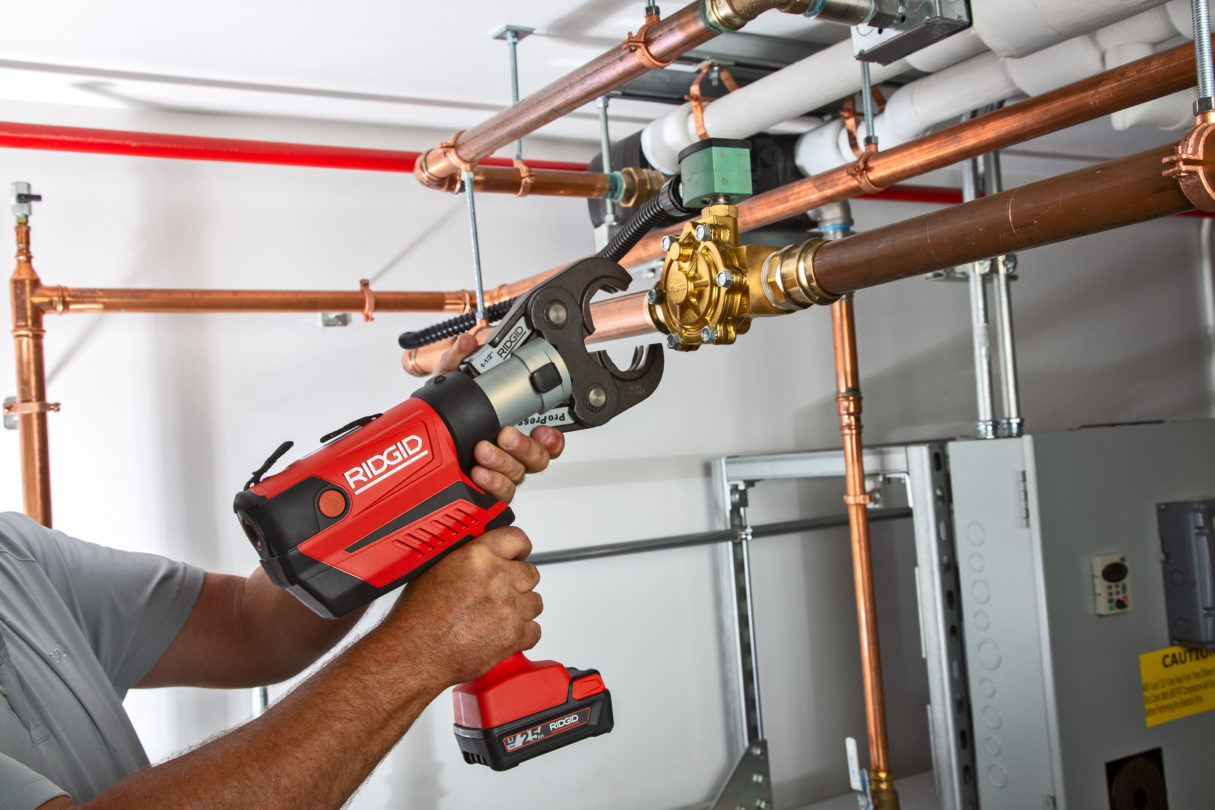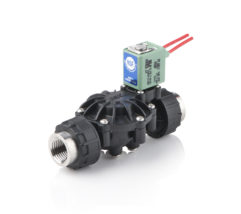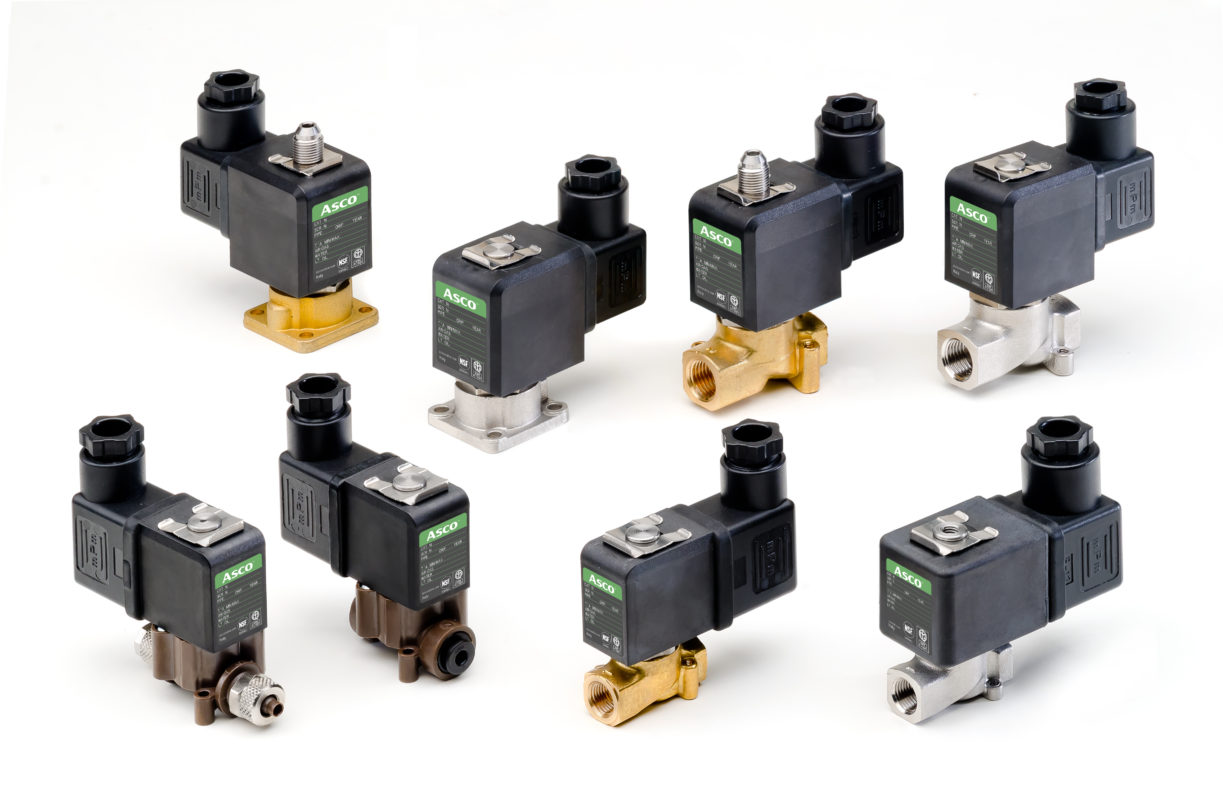Lead is a toxic metal that negatively affects the human brain and central nervous system and can result in high blood pressure and decreased kidney function. The effects can be even worse in children and infants and may include learning problems, hearing problems, anemia, reduced IQ, and slowed growth.
People can be exposed to lead through a variety of means, including paint, dust, air, food and drinking water — or a combination of all of these. While a range of environmental regulations has removed it from many common substances, like gasoline and paint, the Environmental Protection Agency estimates that, depending on where people live, drinking water can account for 20% or more of a person’s total lead exposure. As of 2015, it is estimated that 18 million Americans are served by water systems that violate the EPA’s Lead and Copper Rule.

ASCO™ Series K210 Lead-Free Brass Valve with RIDGID RP 350 Press Tool
To address this challenge, new federal regulations were introduced in the past decade with the adoption of the U.S. federal Reduction of Lead in Drinking Water Act that amended Section 1417 of the Safe Drinking Water Act. It established that not more than a weighted average of 0.25% lead be present when used with respect to the wetted surfaces of pipes, pipe fittings, plumbing fittings and fixtures and not more than 0.2% lead content present in solder and flux.
Compliance is required only for new installations or older sites retrofitted with new equipment. Commercial and municipal water companies, as well as companies building and installing various kinds of water automation systems in commercial, institutional and residential facilities, need to consider the materials used to create the components that build the water transport and handling applications.
The challenge is making technology choices that help reduce the prevalence of lead-containing materials in these systems. This impacts not only the piping but also valves for almost any kind of clean water applications.
THE LEAD-FREE CHALLENGE
Under the law, lead-free is a “cumulative” concept — some parts can be over the 0.25% number, and some can be under it. Specifiers and buyers can “add up” the lead content of all wetted components to get an average system percentage that comes in either at or under the 0.25% lead content requirement. This total wetted surface area calculation can provide a path to compliance, but it involves a series of complex calculations.
For OEMs or equipment builders who have direct access to suppliers, this calculation is possible if the surface area and lead content of all wetted surfaces can be obtained. However, in-field installations, where full component information is not readily available to inspectors, they’re more likely to look at each component. In these instances, clear marking of lead-free compliance (i.e., an “LF” stamp or embossing mark) eliminates any questions of compliance with the new law.
MORE CONVENIENT, MORE PRACTICAL SOLUTIONS
Products with complex geometries can lead to tricky calculations in an attempt to meet the 0.25% or less lead content requirement. A simpler, safer lead-free solution is often more practical.
A range of lead-free solutions are now available to upgrade existing water systems or for use in new construction, including stainless steel, engineered composites and lead-free brass. Many of these products are being designed as drop-in replacements for traditional brass valves and offer numerous benefits.
Plastic composites
Some companies now offer engineered plastic products that meet the new, stricter regulations. OEMs who choose valves made of engineered plastics don’t need to be concerned about the wetted average surface calculations necessary with traditional brass valves.
Leading manufacturers are engineering a new generation of valves with composite or thermoplastic materials, fabricated using strict quality processes and improved designs, making them both cost-effective and reliable options for a range of applications.
Stainless-steel
Most stainless-steel valves are inherently lead-free and provide the durable, corrosion-resistant performance required in many water system applications. An extremely hard material, stainless steel is a more difficult metal to machine, particularly when fabricating valves and other fixtures with complex geometries — thus increasing cost. There may also be local building and plumbing codes that require stainless steel components in certain applications.
Lead-free brass
It’s important to note that many common, more traditional brass products contain lead along with small amounts of other materials. Lead helps soften the brass alloy, making it easier and less costly to machine. However, this means that common brass valves and other plumbing fixtures have lead content ranging from 1.5% to 2.5%.
A system designer or specifier may assume they are reducing the lead content in the wetted path, but that reduction may not be as significant— and could be exposed during a field inspection.
Specially formulated “lead-free” brass alloys, with lead content smaller than the mandated limit of 0.25%, are now available and allow the creation of products like valves that were formerly too difficult to manufacture.
Choosing the right product can help meet safe drinking water requirements and reduce inspection delays — both with the EPA for water safety and UL/CSA for NEC compliance.
IT’S EASIER THAN EVER TO GET THE LEAD OUT
Investing in lead-free from the beginning instead of being “just good enough” is often the smartest — and fastest — solution. Using lead-free components can eliminate complex calculations and immediately reduce inspection delays.
A wider variety of product options meets varying needs, allows for more creative solutions, and helps make the lead-free transition easier while reducing design limitations. Look for fitting options like press fit, which are compatible with reliable connection systems like RIDGID, for increased versatility, improved efficiency, and reduced labor costs.
Both press fit and NPT have proven to be popular with contractors, and many lead-free options are now available with these connection options. For projects like upgrading or replacing legacy water systems where the labor to dig up and replace the infrastructure is expensive, companies can now choose lead-free valves and other components to help manage cost with less labor-intensive connections.
Products like lead-free brass valves provide a useful and cost-effective tool in the incremental process of providing lead-free water. When updating a system to “lead-free” status, or in the development of a new system, you can either calculate everything or simply use lead-free components.
For more information about our lead-free solutions visit our website Emerson.com/LeadFree






